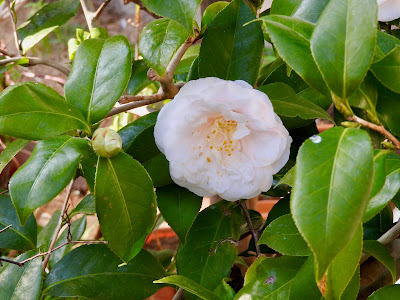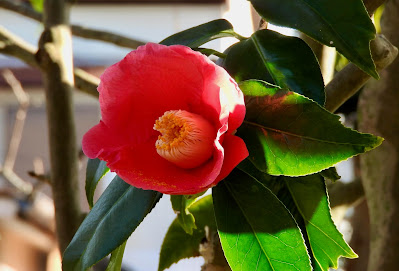目次 / Contents
1) 蕪珈琲 / kabura coffee
2) 収玄寺 / Shugenji-Temple
3) 庭 / Garden
1) 蕪珈琲 / kabura coffee
 |
| '蕪珈琲' (カブラコーヒー) は、収玄寺の境内にあるカフェです。 以前から収玄寺を訪れてみたいと思っていましたが 先にこのカフェを訪ねることになりました。 'kabura coffee' is a cafe in the precincts of Shugenji - Temple. I had wanted to visit Shugenji -Temple, but I visited this cafe first. |
古民家を東京藝術大学院・建築専攻研究室の方がリノベーションしたそうです。
外見は古民家のイメージではなく、ちょっと倉庫のようです。
元々は古民家は大正時代以前の家をさす場合が多かったけれども、
最近は昭和時代の家をも含めて、そう呼ぶように私は感じています。
鎌倉は古民家を利用したカフェが多くあり、多くは脇道、路地に位置しています。
その中でここは、モダンなデザイン・センスとお寺の境内にあるというロケーションに特徴があるように思います。
また、主要道路:県道32号藤沢鎌倉線に面しているので、探し回らずに、簡単に利用できる点も良いと思います。
近くに長谷寺、大仏、江ノ電長谷駅、由比ヶ浜など鎌倉を代表する観光スポットに恵まれています。
海外からの観光客や時間がない観光客には嬉しい場所なのではないかと推測します。
'蕪' (カブラ)というネーミングは精進料理のイメージがし、お寺と合っていると感じます。
本当の由来は、蕪の意味には野菜だでけなく、'雑草が繁っている荒地' という意味があり、カフェの場所が雑草が繁っていたからということらしいです。
It seems that a person from the architecture laboratory of Tokyo University of the Arts has renovated an old folk house : 'Kominka'.
The appearance is not the image of a 'Kominka', but a little like a warehouse.
Originally, 'Kominka' often referred to houses from before the Taisho Period, but I feel that nowadays 'Kominka', includes houses from the Showa period.
There are many cafes in Kamakura that use 'Kominka', and most of them are located on side roads and alleys.
Among them, I thought that this place is characterized by its modern design sense and its location in the temple grounds.
Also, because it faces the main road : Prefectural Road No. 32 Fujisawa Kamakura Line, I think it's good that you can easily use it without searching around.
The location is blessed with sightseeing spots that represent Kamakura, such as Hasedera-Temple, the Great Buddha, Enoden Hase Station, and Yuigahama Beach.
I presume that it is a nice place for tourists from overseas and tourists who do not have time.
The name 'kabura' (turnip in Japanese) has the image of Shōjin Ryōri : Buddhist Vegetarian Meal and I feel that it matches the temple.
The true origin is that the meaning of 'kabura' is not only vegetable: turnip, but also 'weedy wasteland' in Japanese and the place of the cafe was weedy.
他のお客さんを避けて撮影したので、お店全体の写真が撮れませんでした。
I couldn't take photographs of the whole cafe because I avoided other customers.
 |
椅子 椅子のデザインが素朴で綺麗です。 寛げるタイプではないですが、 お寺のイメージと合っていると思います。 Chair The design of the chair is simple and beautiful. It is not the type to relax, but I think it matches the image of a temple. |
 |
| 飾ってある花も素敵 The flowers on display are also lovely.   |
 |
| レコード! Rはレコード派なので、嬉しいのではないですか? Record! R is a 'record nut', so he is pleased isn't he? |
 |
| 石碑を裏から 道路を歩いているとこの石碑がとても目立ちます。 Stone Monument from Behind This stone monument stands out very much when walking along the road. |
 |
| メニュー / Menu |
 |
| カフェからのアプローチ カフェからも正門からも庭へ行くことができます。 Approach from Cafe You can reach the garden from both the cafe and the main gate. |
2) 収玄寺 / Shugenji -Temple
 |
| 収玄寺の正門 Main Gate of Shugenji -Temple |
 |
| 収玄寺 : ★は、日蓮宗の寺院です。 山梨県の久遠寺 (クオンジ) が日蓮宗の総本山です。 お参りはきちんとしました。 Shugenji - Temple is a temple of the Nichiren Shū. Kuonji - Temple in Yamanashi Prefecture is the head temple of Nichiren Shū. We worshiped. |
 |
四条 金吾 (シジョウキンゴ )、または、 四条 頼基 (シジョウ ヨリトモ / 1229 - 1296) 。 説明板では名前が合わせられています。 四条氏は日蓮の熱烈なファンでした。 収玄寺は、彼の屋敷跡に、文政年間 (1818 - 1829 ~30)に、 創建された"収玄庵"が元になっていると言われています。 |
下記、aquadina観光サイトより
"頼基が亡くなった後、妙詣尼によって、四条頼基の法名「収玄院日頼」から名づけられた「収玄庵」という寺が開かれたが、後継者がおらず次第に荒廃していった。
(妙詣尼は、四条金吾夫人です。)
 |
Kingo Shijō or Yoritomo Shijō (1229 - 1296). The names are combined on the explanation board. Shijō was an avid fan of Nichiren. It is said that the origin of this Temple was the "Shugen-an : Shugen hermitage" built on the site of Kingo Shijō's house in the Bunsei era (1818-1829 ~ 30). |
According to a website : aquadina only in Japanese (Translated by me)
"After Shijō died, a temple called 'Shugen-an', named after Shijo Kingo's legal name, 'Shugen-in Niyori', was opened by Myojo-nun, but it was gradually devastated without a successor.
A priest, Nichiyu of Ankokuronji-Temple, who thought about it, was promoted, and the main hall was rebuilt by a priest, Nichiji of Kosokuji-Temple, and it has been called 'Shugenji-Temple'."
(Myojo-nun was Mrs. Kingo Shijō.)
 |
| 四条金吾邸址・石碑 刻まれている文字は、 東郷 平八郎 (トウゴウヘイハチロウ / 1848 - 1934) の 揮毫 (キゴウ) です。 Stone Monument of 'Site of Shijō Kingo Residence' The writing of the inscription is by Heihachiro Tōgō (1848 - 1934). |
石碑は、日蓮宗の信者であったと言われている東郷平八郎によって建てられたものだそうです。
東郷平八郎が日蓮宗の信者であったことを知りませんでした。
東郷平八郎は、自分の死後、神格化され神社ができることに反対し、墓所は母親の眠る青山墓地への埋葬を希望しましたが、どちらも後世の人々によって聞き入れられませんでした。
東郷神社、東郷寺はでき、彼は多磨霊園に埋葬されました。
下記、東郷 平八郎についてWikiより。
"日露戦争においては、連合艦隊を率いて日本海海戦で当時世界屈指の戦力を誇ったロシア帝国海軍バルチック艦隊を一方的に破って世界の注目を集め、アドミラル・トーゴー(Admiral Togo 、東郷提督)としてその名を広く知られることとなった。
「陸の大山 海の東郷」と称され国民の尊敬を集めた。"
収玄寺は、日蓮宗で、海軍の英雄の揮毫をもち、手入れの行き届いた庭があり、個性的なカフェがある、アミューズメント的なお寺に感じます。
The stone monument is said to have been built by Heihachiro Tōgō, who is said to have been a believer in Nichiren Shū.
I didn't know that Tōgō was a believer in Nichiren Shū.
Tōgō objected to the deification of a shrine after his death and wanted to be buried in the Aoyama Cemetery where his mother sleeps, neither of which was respected after his death.
Tōgō Shrine and Tōgōji -Temple were built, and he had been buried in Tama Cemetery.
"Marshal-Admiral the Marquis Tōgō Heihachirō (1848 - 1934), served as a gensui or admiral of the fleet in the Imperial Japanese Navy and became one of Japan's greatest naval heroes.
As Commander-in-Chief of the Combined Fleet during the Russo-Japanese War of 1904–1905, he successfully confined the Russian Pacific naval forces to Port Arthur before winning a decisive victory over a relieving fleet at Tsushima
in May 1905.
Western journalists called Tōgō "the Nelson of the East"."
Shugenji -Temple is a Nichiren Shū temple, and here feels like an amusement temple with a hero of the Navy, a well-maintained garden, and a unique cafe.
3) 庭 / Garden
 |
| 河津桜 カフェの窓から見えた河津桜 (カワヅザクラ)。 鎌倉宮の河津桜は、どうなっているかしら?と思って コーヒーをいただきました。 Kawazu-zakura Cherry Tree Kawazu-zakura Cherry Tree seen from the window of the cafe. While I had coffee, I wondered how about Kawazu-zakura blossoms in Kamakura-gū ; a shrine in Kamakura? |
 |
| ミツマタ ミツマタ (三椏) は、門前に左右一対で植えられています。 Mitsumata A pair of Mitsumata (Edgeworthia Chrysantha) are planted on the left and right in front of the gate.  Rにミツマタは和紙の原料になるのだと伝えたかったのですが、 言い忘れました。 I would tell R that Mitsumata is a raw material for Washi : Japanese paper, although I forgot to say it.  次回の個展 (2022年4月予定) は、 和紙を使用したいと考えているのでこのミツマタが そのアイディアをさらに後押ししたように感じました。 For my next Exhibition (scheduled for April 2022), I would like to use Washi, so I felt that this Mitsumata further boosted the idea.  |
 |
| 紅梅または桃の花 Red Ume : Red Plum or Peach's Flowers  紅梅と思ったのですが桃の花かもしれません。 I thought it was Red Plum: Red Ume, but it may be a peach blossom.  |
 |
| 椿 造花のような色ですが、本物の花です。 Camellia The colour is like an artificial flower, but they are real flowers. |
 |
| この花の名前がわかりません。 I don't know the name of this flower. |
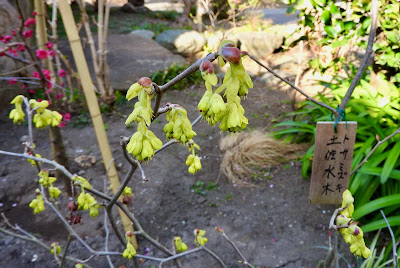 |
| トサミズキ ここで初めて知った花(木)、トサミズキ (土佐水木)。 Corylopsis Spicata : Tosamizuki The first flower (tree) I recognized here, Corylopsis Spicata (winter hazel) : Tosamizuki.  面白い形の花です。 It is a flower with an interesting shape. |
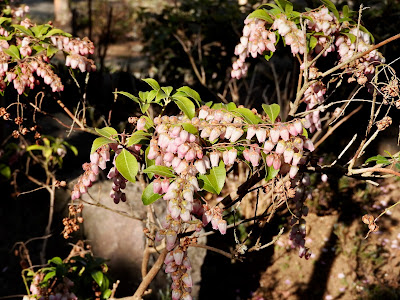 |
| 最初、ボロニアかと思いましたが違いました。 違うことはわかりましたが、この花の名前はわかりません。 At first, I thought it was Boronia, but it wasn't. I know it's different, but I don't know the name of this flower.  |
 |
| 橘 七里ヶ浜住宅街を散策中に、この植物を見かけ、 何かと思っていました。 この庭で、橘 (タチバナ)だとわかりました。 橘の名前は知っていましたが、実際の木と結びついて いませんでした。 わかった今でも、黄色い実がついてない場合は、 橘だとわからないかもしれません。  Tachibana While strolling around the Shichirigahama residential area, I saw this plant and wondered what it was. In this garden, I found out that it was Tachibana. I knew Tachibana's name, but it wasn't related to an actual tree. Even now, if it doesn't have yellow fruits, I may not know that it is Tachibana. |
 |
| 道路沿いの庭 / Garden Along Road |
 枝垂梅 先日、鎌倉山で、白い枝垂梅 (シダレウメ) を見ました。 これはピンク。 Weeping Plum : Weeping Ume The other day, I saw a white weeping ume in Kamakurayama. This is pink. |
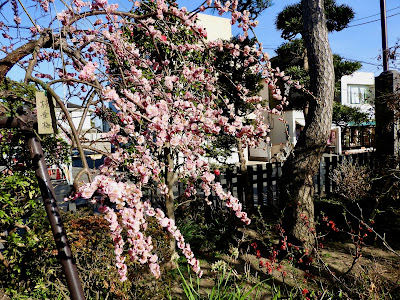 |
 |
| 木瓜 木瓜 (ボケ) はなんとなく、お寺にあっているような気がします。 Japanese Quince : Boke I feel that somehow the quince suits a temple. 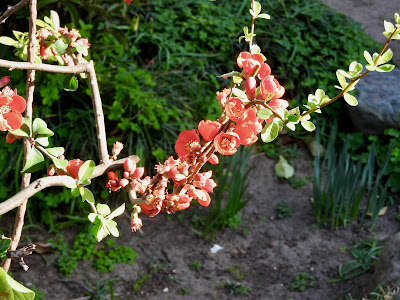 |
 |
| 木瓜 咲いている花は綺麗ですが、蕾もおもしろいな〜と思い 撮影しました。 Quince The flowers in bloom are beautiful, but the buds are also interesting, so I took this photograph. |
 |
| 黄色はラッパスイセン 白は? Yellow is daffodil. What about the white? |
 |
| ハナニラ ハナニラでしょうか? ハナニラならば、別名がベツレヘムの星。 日蓮宗のお庭にあるのが面白いです。 英語では、'春の星の花'。 Spring Starflower : Hananira Is it Hananira : Spring Starflower( Ipheion uniflorum) ? For Hananilla, another name is the Star of Bethlehem. It is interesting that it is in the garden of Nichiren Shū. |
 |
| 本堂裏 / Behind Main Hall |
カフェの '蕪珈琲' は、私にとっては、一度の経験で十分に思いますが、お庭には違う季節にまた訪れたいです。
I think that for me, the Cafe, 'kabura coffee', one experience is enough, but I would like to visit the garden again in a different season.
















